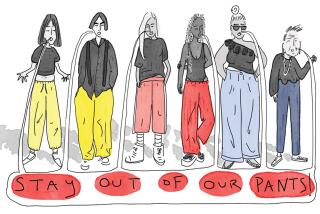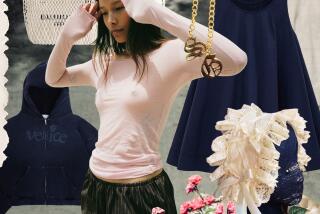Swimwear alert: One-piece swimsuit appears to have eclipsed the bikini this summer
- Share via
Minuscule swimsuits have long been interwoven in beach culture’s plotline, offering a fixed expression of summertime femininity and sex appeal — from Bond girls to Bo Derek to Sports Illustrated. But this paradigm is now outdated, designers say, with many of them experiencing surging sales of demure one-piece suits.
The bikini — once a brazen symbol of female empowerment — has, in some cases become a confining emblem of scrutiny and objectification. For many, it has come to represent an old-fashioned image of sensuality. Even the Miss America pageant has moved beyond them — removing the flagship swimwear contest from its lineup earlier this year, citing an eagerness to evolve “in this cultural revolution.”
One-pieces are now top performers with teen lines such as RVCA, were named to Macy’s “It List” of summer trends to buy, and this season blanket swim assortments at Zara and Urban Outfitters.
But the new one pieces are far from the clinical swim team uniforms of the past, instead featuring cheery prints, provocative cutouts, ruffles and nostalgic silhouettes.
Even Jenners are in on the moment — Kendall sporting a plunging black maillot to sail around Cannes, France, and Kylie wearing a purple metallic foil suit to plug her summer line of color cosmetics. Surprising in both cases, as the sisters are not often lauded for sartorial restraint.
Designers say that the suits are alluring in their restraint, while also allowing women greater mobility at the beach and by the pool.
Former American Apparel designer Eliana Gil Rodriguez launched her namesake collection last week. Her line includes a single swimwear style — a one-piece. “A bikini — it’s sexy, it shows a lot of skin in a very obvious way. A one piece is less obvious. I think that skin doesn’t really shock anyone anymore, we are constantly bombarded with flesh. If anything, modesty now is just a little more intriguing than ever before,” she said.
Michelle Copelman, former design director at Solid & Striped who recently departed to launch her own line in 2019, noted of the change: “It’s interesting, the bikini was empowering and part of women taking control of their sexuality. But because it had been so prevalent for 30, 40 years, we are almost taking it back yet again.
“Now it’s about saying, ‘Just because I am a sexual person, doesn’t mean I have to portray that in what I’m wearing.’ You can be empowered and sensual but not necessarily on a superficial level.”
This is not to say the bikini has been sidelined altogether. “I think both [styles] have their place at end of the day,” Gil Rodriguez said. A large portion of new bikini designs flaunt high-waisted bottoms and max-coverage tops — invoking nearly the same modesty as many one-pieces. Ditto the tankini’s recent return.
The beach — long the place where people willingly expose themselves the most — has also become the primary domain of summer Instagram posts, Snapchats and digital storytelling. Various global beach cultures appear under review as a result.
Europe, perhaps the least modest of beachscapes, is experiencing the shift, according to Copelman. “When I talk to my European friends, the younger generation does not want to go topless — they see it as an old-school mentality,” she said. “My thesis is that social media has changed how we perceive each other — you’d never post a picture of yourself topless for so many different reasons. Now it’s about the idea of capturing the moment and engaging in activities.”
The numbers don’t lie. Net-a-porter has seen one-pieces swimsuits chart 27 percent year-over-year growth. Two-pieces are also growing, albeit at a slower clip — 17 percent for tops and 14 percent for bottoms.
Since launching swimwear in 2014, designer Araks Yeramyan has seen her sales ratio flip from mostly bikinis to one-pieces — with 70 percent of this year’s sales attributed to maillot styles. “I design swimwear for a strong woman; I think my whole brand is about dressing for yourself rather than for a man. It’s dressing for your own identity and how you want someone to see you,” Yeramyan said.
Flagpole, founded by Megan Balch and Jaime Barker, will this year attribute 72 percent of sales to one-pieces, up 12 percent from last year. Said Balch: “We have started to see a shift where women have a lot more ownership over their bodies and decide how sexy we want to look and feel. There are so many female-owned suit companies now who are making what fellow women want to wear.”
It’s true that there has been a flood of female designers rushing to the swim market — each offering a unique sensibility. Morgan Curtis’ Morgan Lane skews hyper girly, Caroline Constas veers Tropicana resort, while Los Angeles-based Roxana Salehoun’s vintage shapes look equal parts “The Little Mermaid” and Nineties Ashley and Mary-Kate Olsen film. Countless others have also emerged — many of them report strong one-piece sales across the board.
While they certainly enable a greater sense of mobility, one-pieces, from a design perspective, provide more surface area with which to create innovative, novel designs — helping further ignite sales, designers say.
“Instagram is the new runway. If you post a picture of yourself in a string bikini you’ll get comments on how great your body is, whereas in a one-piece you are saying more and showing a more fashionable side. It’s really where people are spending more time and energy developing [new designs] right now,” Balch said.
Added Constas: “One-pieces are a little more like an outfit. I think it gives people a little more versatility. I think they definitely lend themselves to a wider audience — certainly many different body types, which is a great thing. It’s empowering for women to have more options.”
As Copelman summarized: “I would hate to think women feel an ongoing constant pressure — it’s our vacation, too.”







